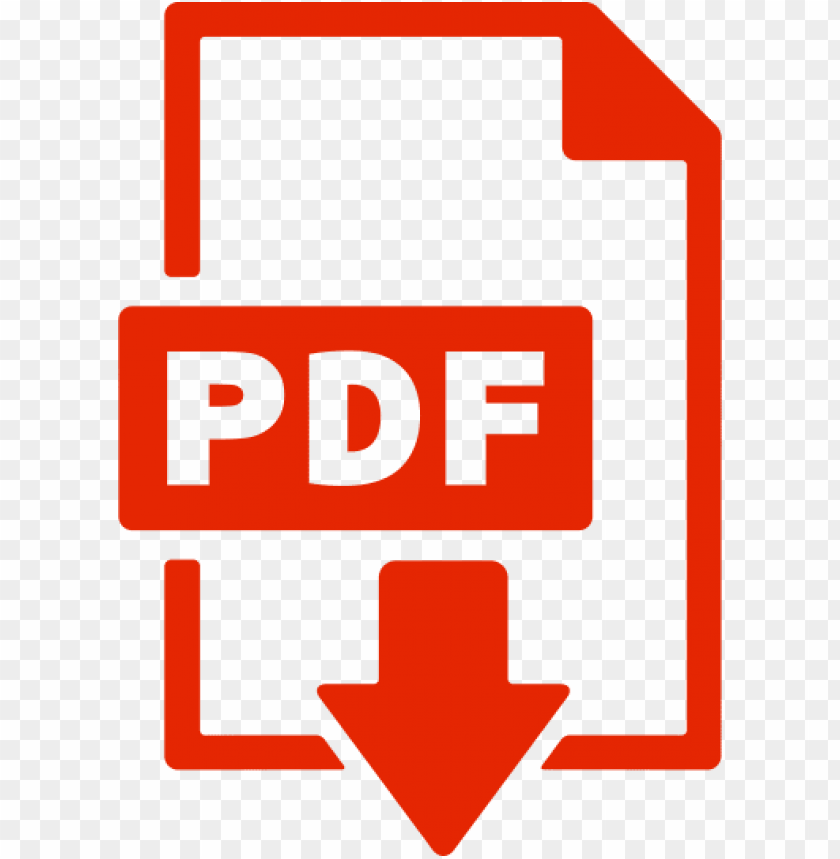January 2025
General Announcement
- IAG2025 Scientific Assembly: Abstract submission now open
- Announcement of an Open position at FGI
Meetings Calendar
IAG Sponsored Meetings
- 3rd ICCC Workshop – Geodesy for Climate Research
- 6th Joint International Symposium on Deformation Monitoring (JISDM)
- 3rd Commission 4 Symposium
- IAG Scientific Assembly 2025
Geodesy Related Meetings
- Geodesy Capacity Building Workshop for Europe
- 2025 Glacial Isostatic Adjustment workshop: Advancing Models and Observational Constraints
- IAU Symposium 401: Advancing Reference Systems, Ephemeris, and Standards
Reports
- Report of Gravity Geoid and Height Systems 2024 – GGHS2024
General Announcements
IAG Scientific Assembly 2025 - Abstract submission now open
September 1-5 2025, Palacongressi, Rimini, Italy
https://eventi.unibo.it/iag2025

The first circular for the IAG2025 Scientific Assembly was published in the previous newsletter. It can be downloaded from the website of the Assembly. The Assembly website is ready to receive abstracts, see https://eventi.unibo.it/iag2025. The deadline for submitting abstracts is 15 March.
Scientific Program
Scientific program will be published in July 2025. Below you can find all topics of the Scientific Assembly
| Symposia | Sessions within Symposia |
| G01 Reference Frames | |
| G01-1: Space Techniques: Prerequisites for current and future terrestrial and lunar missions G01-2: International Terrestrial Reference Frame: Challenges, future developments and applications G01-3: Regional Reference Frames: Status, Challenges and Applications G01-4: The International Celestial Reference Frame for Geodetic Applications: Requirements, Challenges, and Future Prospects | |
| G02 Gravity Field – Science Inference | |
| G02-1: Gravity Field and Reference Systems in Physical Geodesy G02-2: Hydrological and Cryospheric Applications from Gravity and Satellite Altimetry G02-3: Oceanography and Solid Earth Science from Gravity and Satellite Altimetry | |
| G03 Gravity Field – Technology and Techniques | |
| G03-1: Next Generation Technologies G03-2: Terrestrial Gravimetry G03-3: Spaceborne Gravimetry G03-4: Analysis, algorithms, and Models | |
| G04 Earth Rotation and Geodynamics | |
| G04-1: Geodetic Constraints and Modeling of Glacial Isostatic Adjustment and Cryospheric Deformation Across Time Scales G04-2: Tidal and non-tidal mass signatures in space and surface geodetic observations G04-3: Monitoring and Modelling of Earth Orientation Parameters Across Temporal Scales G04-4: Open Session on Earth Rotation and Geodynamics | |
| G05 Advances in GNSS, Positioning Technologies and Engineering Geodesy | |
| G05-1: Emerging Positioning Technologies and GNSS Augmentations G05-2: Multi-frequency, Multi-constellation GNSS G05-3: GNSS for Troposphere G05-4: Engineering Geodesy | |
| G06 Global Geodetic Observing System | |
| G06-1: Contribution of geodesy to Earth observations G06-2: Global geodetic infrastructure for Earth System Monitoring G06-3: Standardization, integration and optimization of geodetic products G06-4: Enhancement of GGOS collaboration at regional level | |
| G07 ICCT – Advances in Geodetic Theory | |
| 1: Gravitational field modelling and analysis for the Earth and for oblate and prolate planetary bodies and irregularly shaped celestial bodies 2: Geoid/quasigeoid modelling approaches in view of cm-precision/cm-accuracy 3: Height datum: definition, new concepts, and standardization 4: High-precision GNSS theory and algorithms 5: Geodetic quality/integrity modelling, monitoring and design | |
| G08 Geodesy for Climate Research | |
| G09 Seafloor Geodesy, Marine Positioning and Undersea Navigation | |
| G10 Modern Concepts and Quantum Technology for Geodesy | |
| G11 Geodesy for Society: Data Management, Policy Networking and Public Engagement | |
| G11-1: Data Management, Dissemination of Results, and Stakeholder Networking G11-2: Geodesy at the Intersection of Science and Policy G11-3: Communication, Education and Outreach in Geodesy |
Joint Symposia
| J01: Geodetic Space Weather Research | |
| J02: Artificial Intelligence and Machine Learning in Geodesy | |
| J021: Geodetic machine learning: Theoretical challenges and opportunities for geodesy 2: AI for Deformation Analysis and GNSS Remote Sensing: Earth, Atmosphere and Natural Hazards 3: Decoding Earth's Dynamics: Machine Learning Frontiers in EOP and Gravity Field Assessment | |
| J03: Geohazards Monitoring through Geodesy |
Highlight Sessions
| H01 Future Geodetic Satellite Missions and new Technologies | |
| H02 Northeast Italy with focus on the Po Plain – Impacts of changing climate on the region | |
| H03 Geodetic Monitoring for Geohazards | No Call-for-Abstracts; Presentations will be by invitations only |
| H04 Geodesy for Climate and Water | No Call-for-Abstracts; Presentations will be by invitations only |
Announcement of an Open position at FGI
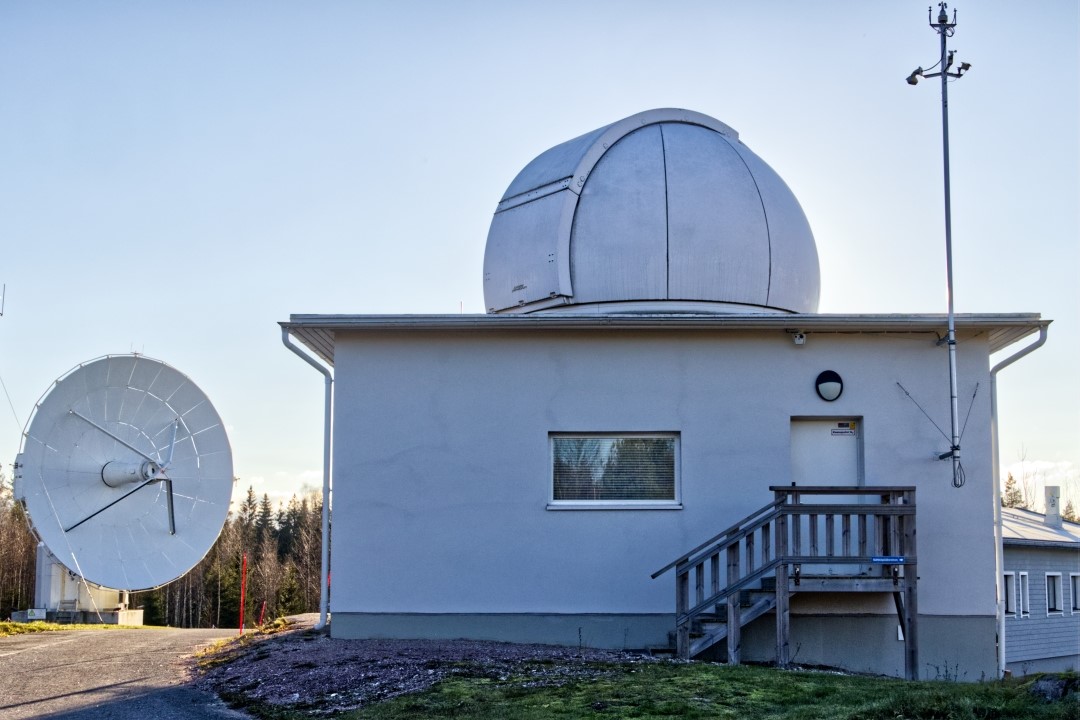
The Finnish Geospatial Research Institute (FGI) is seeking a postdoctoral researcher to join the Space Geodesy group in the Department of Geodesy and Geodynamics. The research will be related to space geodetic techniques at the Metsähovi Geodetic Research Station. Metsähovi hosts several modern geodetic techniques, including VLBI, SLR, and GNSS.
This is a three-year fixed-term position from June 1, 2025, to May 31, 2028. Please find more details in the job announcement:
Markku Poutanen
Meetings Calendar
IAG Sponsored Meetings
- 3rd ICCC Workshop – Geodesy for Climate Research, March 24-25, 2025, online
URL: https://iccc.iag-aig.org/iccc-workshops/ws25 - 6th Joint International Symposium on Deformation Monitoring (JISDM), April 7-9, 2025, Karlsruhe, Germany
URL: https://jisdm2025.gik.kit.edu/ - 3rd IAG Commission 4 Symposium, May 13 – 15, 2025, Wuhan, China
URL: https://iagc4.bdsmart.cn/ - IAG Scientific Assembly 2025, September 1 – 5, 2025, Rimini, Italy
URL: https://eventi.unibo.it/iag2025
Geodesy Related Meetings
- Geodesy Capacity Development Workshop for Europe, February 17-21, 2025, Bonn, Germany
URL: https://ggos.org/2024/10/16/ggce-workshop-europe-reference-system/ - 2025 Glacial Isostatic Adjustment workshop: Advancing Models and Observational Constraints, 2025 Glacial Isostatic Adjustment workshop: Advancing Models and Observational Constraints, June 2-6, 2025, Sydney, British Columbia, Canada
URL: https://polenet.org/2025-gia-workshop/ - IAU Symposium 401: Advancing Reference Systems, Ephemeris, and Standards, August 4 – 9, 2025, La Plata, Buenos Aires, Argentina
URL: https://iaus401.fcaglp.unlp.edu.ar/
Report
Report of Gravity Geoid and Height Systems 2024 – GGHS2024
Joint IAG Commission 2, IGFS and GGOS Symposium
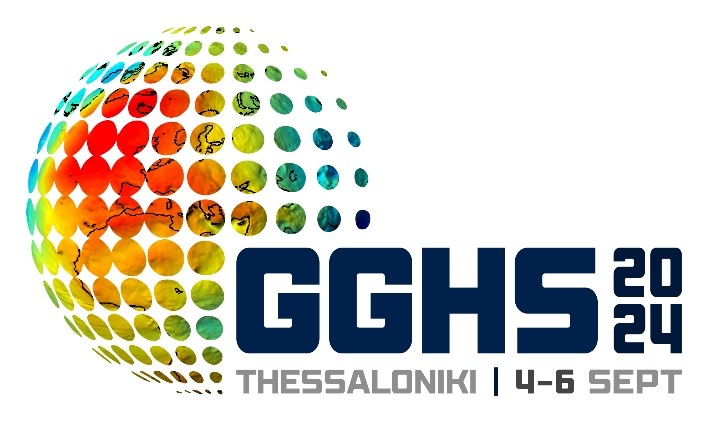
The GGHS2024 “Gravity, Geoid and Height Systems 2024” Symposium was co-organized by the International Association of Geodesy (IAG) Commission 2, the International Gravity Field Service (IGFS) and the Global Geodetic Observing System (GGOS). It took place in Thessaloniki, Greece between September 4-6, 2024 at the premises of the Aristotle University of Thessaloniki Research Dissemination Center (KEDEA). It focused on methods for observing, estimating and interpreting the Earth’s gravity field and the essential role of gravity field modelling in measuring, understanding and predicting changes in the Earth system.
GGHS 2024 continues the long history of IAG gravity field related symposia:
- initially hosted by the IAG Commission 2, GGG2000 (Banff, Canada), GG2002 (Thessaloniki, Greece), GGSM2004 (Porto, Portugal), GGEO2008 (Chania, Greece), GGHS2012 (Venice, Italy)
- those organized by the IGFS, 1st IGFS Meeting 2006 (Istanbul Turkey), 2nd IGFS Meeting 2010 (Fairbanks, Alaska, USA), 3rd IGFS Meeting 2014 (Shanghai, China)
- and more recently the joint IAG Commission 2 and IGFS Symposia, GGH2016 (Thessaloniki, Greece), GGHS2018 (Copenhagen, Denmark) and GGHS2022 (Austin, Texas).
GGHS2024 was composed by 6 sessions spanning the entire 3 days of the program. During all days, the first three sessions were devoted to oral presentations, followed by short-oral presentations of the posters during the last oral slot. This new format showed very positive response from the majority of participants. Every day, the poster session followed the oral presentations and was organized between 6 p.m. and 8 p.m.. A conference welcome reception was organized during the first day of the conference, followed by the official dinner during the second day.
For GGHS2024, 125 abstracts have been received, out of which 58 have been scheduled as oral presentations and 67 as posters. 130 participants from 26 countries participated in the conference. It should be particularly emphasized that this symposium was able to attract also the young generation of scientists, since 48 participants (~38% of the total number) have denoted that they are Early Career Scientists (ECS).
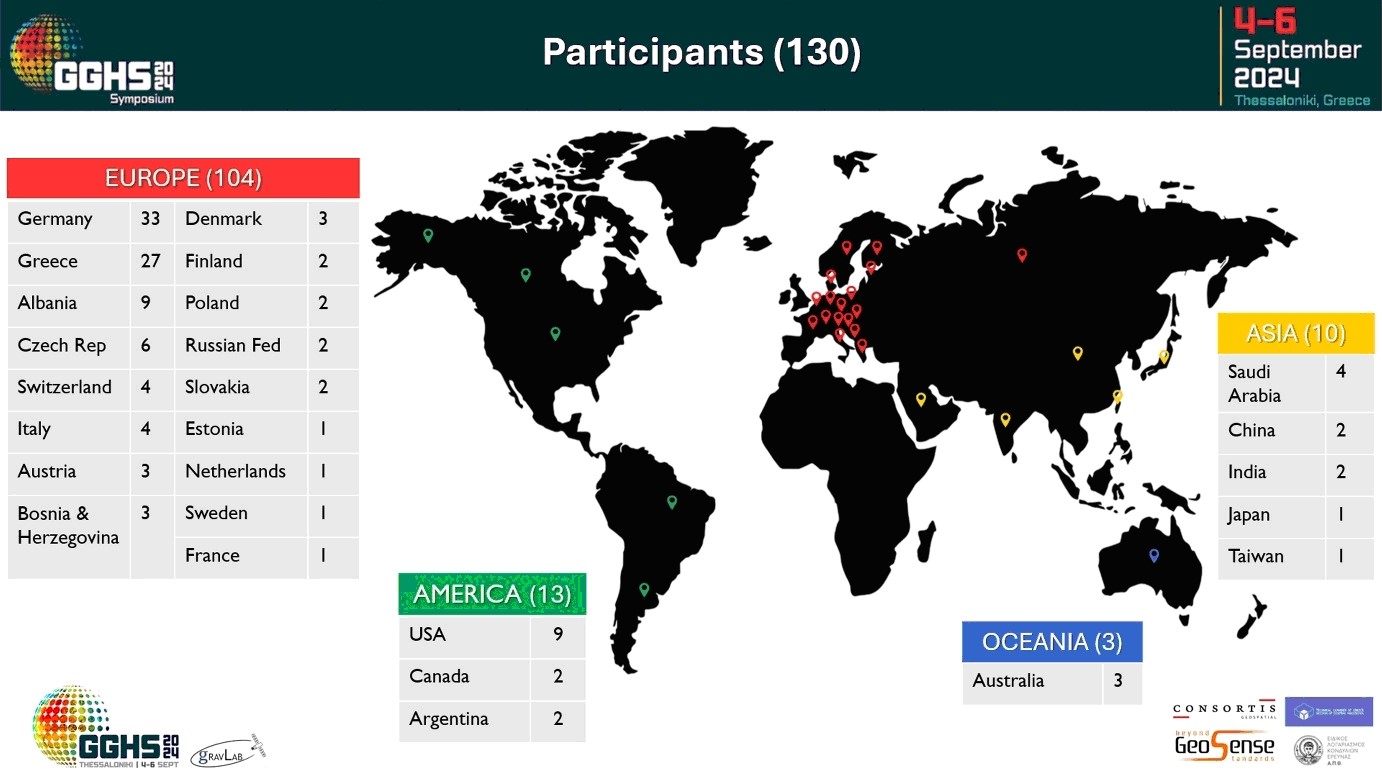
Distribution of GGHS2024 participants
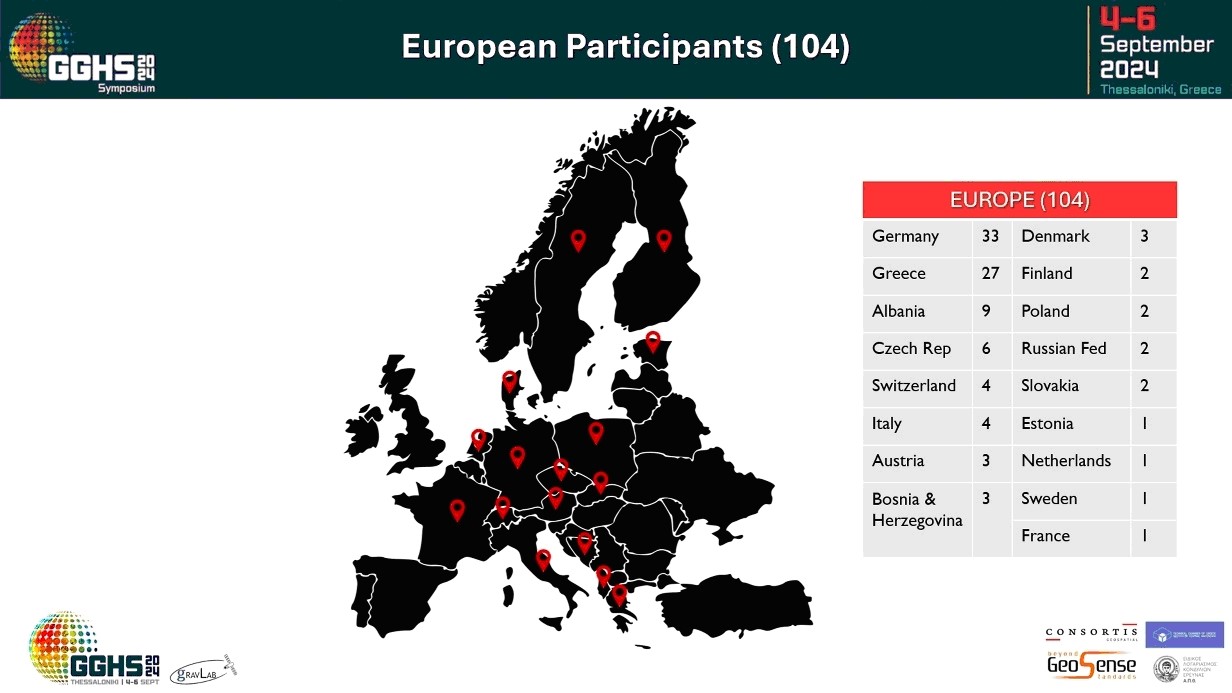
A focused view of the distribution of GGHS2016 participants over Europe
For ECSs, Athina Peidou, as IAG Commission 2 ECS Representative, organized with Rebecca McGirr an informal ice-breaker, a walk through the city of Thessaloniki, which is a unique example of a city that blends roman, byzantine, and modern history in its urban design, along with a social gathering close to the old agora district. All ECS fellows were excited and participated in big numbers in the spin off events. Interest and participation were beyond expectations. Positive feedback has been received for bringing early career representative into IAG, an action that is greatly appreciated as to having a special forum. For some of the ECS, GGSH2024 was the first ever conference they attended, thus the short oral presentations of posters, was well received as it gave the opportunity to all graduate students to present their work in both formats.
The scientific program of GGHS2024 was of outstanding quality and showed significant scientific advancements in several fields of gravity field research, which are briefly summarized in the following:
Session 1: Reference systems and frames in Physical Geodesy
(Chairs: Riccardo Barzaghi, Laura Sánchez, Hartmut Wziontek)This session comprised three main topics: precise geoid modelling as reference surface for physical heights, new concepts and methods for the realisation of geopotential-based height systems, and absolute gravimetry as cornerstone for the realisation of the International Terrestrial Gravity Reference Frame (ITGRF).
Ongoing studies related to these topics were presented along 14 oral contributions and 15 posters. In the case of precise geoid modelling, advances/refinements in the geoid determination in the Baltic Sea, Japan, USA, Greece, India, Italy and Albania were presented. Regarding geopotential-based height systems, special attention was given to the implementation of the International Height Reference Frame (IHRF). A first solution for its global realisation was presented, complemented by study cases for its regional densification in Italy, Sweden and Argentina and the establishment of the IHRF Coordination Centre as the main administrative body for the long-term maintenance of the IHRF. Some contributions also dealt with a roadmap for geopotential-based height systems, error tree analysis of geopotential models, temporal evolution of physical heights, modernisation of the vertical reference system in Switzerland, and new concepts for height datum definition and standardisation. The definition of normal gravity fields were reviewed and revisions were proposed in order to achieve compatibility with the reference potential of the IHRS.
The contributions related to absolute gravimetry concentrated on the concepts for the realization of the ITGRF with focus on the comparisons of absolute gravimeters and the long-term stability of the comparison reference values. The permanent tide was discussed with respect to recent updates of the ITRF and their consequences for the ITGRF, suggesting to keep a stable mean pole for the correction of polar motion effects, in favour of long-term consistency. The compatibility of numerical weather models for the correction of atmospheric effects in absolute gravimetry in accordance with the ITGRS 2020 conventions was introduced. Exceptional accuracy and stability of repeated absolute gravity measurements in Czech Republic were demonstrated, enabling to document small seasonal gravity variations of mainly hydrological origin. Updated gravity gradients were also presented for these stations. The initiative for a new absolute gravity network in Italy was addressed, as well as the realization and densification of the ITGRF by relative and absolute gravity surveys in the few µGal range, including a discussion about the compatibility of different tidal corrections.
Session 2 (Co-organized with the IAG QuGe Project) Novel technologies in terrestrial, airborne, and satellite gravity field determination
(Chairs: Jürgen Müller, Derek van Westrum, Sylvain Bonvalot)The 8 oral and 10 poster presentations in Session 2 covered an incredible range of new sensor designs, techniques, and applications. In general, a theme of “sensor fusion” between quantum and classical techniques emerged as deployment and testing of cold-atom systems starts to become a reality. Numerous simulations of quantum interferometers deployed as accelerometers were described for both GRACE-like missions as well as novel CubeSat deployments. The performance of quantum gravimeters in airborne and terrestrial applications was also discussed. Furthering another novel technique, analyses of optical clocks for both chronometric leveling and unified height systems were described.
Advancement in classical techniques continues though, with reports on an improved repeat, “cross-over” analysis for airborne gravity observations, as well as a fusing of spring-based and IMU-based gravity and inertial sensors. Software tools for relative terrestrial gravity measurement reduction were described along with higher order corrections due to non-tidal atmospheric effects. A comparison of ground-based quantum absolute gravimeters seems to indicate some persistent systematic biases in certain instruments, but a decent overall agreement with historical, “classical”, absolute values is achieved, paving the way for more comprehensive uses of these novel sensors in geodesy.
Session 3: Static and time-variable global gravity field modelling
(Chairs: Srinivas Bettadpur, Roland Pail, Adrian Jäggi)Session 3 covered 10 oral talks and 10 poster presentation. The first oral block of the orals were mainly dedicated to the current mission GRACE-FO and contributions from SLR, while the second block addressed future missions such as GRACE-C, NGGM/MAGIC and extended constellations. The main results and conclusions include.
- Large parts of the variations of C20 and C22/S22 derived from SLR can be explained geo-physically, but residual unexplained contributions remain.
- There is very good consistency between KBR and lRI derived temporal gravity fields. LRI post-fit residuals are substantially smaller due to the higher instrument error level of KBR in the higher frequencies.
- Combination of solutions in the frame of COST-G in most cases improve the monthly perfor-mance compared to individual solutions. Recently, five Chinese processing centers could be included in the COST-G combined model. The community is asked to support validation ac-tivities.
- Enhanced stochastic modelling of background model errors have the potential to improve the temporal gravity retrieval.
- Preparations for the next mission GRACE-C (polar pair, target launch date. 2028) and NGGM (70° inclined pair, target launch date. 2032), which will constitute the double pair constella-tion MAGIC, are progressing well.
- The significant added value of a double-pair constellation for geodesy was demonstrated. It can specifically contribute to the realization of the IHRF, both the static and the temporal component.
- In enhanced (multi-)pair constellations, alternative parameterization strategies such as spline parameterization and ocean tide model co-estimation are promising candidates to reduce tem-poral aliasing effects
Session 4: Regional gravity field modelling and geophysical interpretation
(Chairs: Pavel Novák, Mirko Reguzzoni, Ismael Foroughi)Session 4 received 33 abstracts with most preferences given to oral presentations by the authors. Session chairs could provide time slots for 14 oral presentations and the rest had a chance for a quick oral pitch and present their study in poster format. Both oral and poster presentations covered a broad range of topics centred around the advancements in regional gravity field and geoid modelling, gravity data analysis, and geophysical applications. Discussions included high-resolution strapdown gravimetry, airborne gravity vector data for geoid determination, and the use of machine learning, such as Physics-Informed Neural Networks, for local geoid studies. Key challenges, such as modelling in mountainous regions, the effects of Moho depth on height datum determination, and orthogonality of the spheroidal harmonic functions, were also addressed.
The poster session further complemented these themes, with presentations highlighting computational tools for gravity field functionals, and new detailed gravitational models from recent satellite gravity missions and forward modelling of the DEMs. Several contributions focused on the evaluation of marine and regional gravity data, addressing uncertainties in gravity field modelling and the integration of different data sources, including satellite altimetry and shipborne data. Overall, the sessions provided a comprehensive overview of current research and technological advancements in regional gravity field modelling and geophysical interpretation of gravity data.
Session 5: Gravity for climate, atmosphere, ocean and natural hazard research
(Chairs: Annette Eicker, Carmen Blackwood, Rebecca McGirr)The "Gravity for Climate, Atmosphere, Ocean, and Natural Hazard Research" session featured three oral presentations, each showcasing significant advancements in the application of satellite gravity observations. The first presentation outlined how data from GRACE and GRACE-FO are being employed to enhance the Canada 1 Water project, a comprehensive model for monitoring surface and groundwater at both regional and national scales. The second presentation highlighted innovations in applying statistical and neural network methods to separate mass change signals characterised by unique spatiotemporal patterns present in satellite gravity data. The final presentation explored the capabilities of current and planned satellite gravity missions to capture long-term climate signals, demonstrating how different parameterisation schemes can improve the recovery of these trends.
Three posters, accompanied by short oral presentations, were presented, further developing the session's themes of climate and hazard research. The first poster focused on estimating the contributions to sea level change in the Baltic Sea, employing a deep learning method to forecast future changes. The second poster presented an analysis of altimetry data from the Aegean Sea, identifying sea level variations and trends, which informed simulations of future coastal flooding scenarios due to rising sea levels. The final poster analysed an extreme flood event in Thessaly, Greece, utilising SAR data and optical imagery for mapping, along with GRACE-FO data for flood volume quantification.
Session 6: Data management, dissemination of results and networking of stakeholders
(Chairs: Sinem Ince, Daniela Carrión, Martin Sehnal)The Session about “Data management, dissemination of results and networking of stakeholders” hosted six oral presentations and six posters with short oral presentations. The session presented interesting advancements and projects concerning how geodetic data are organized, shared and made available through services and geoportals. With respect to data portals, for GGOS, the details regarding the feasibility study and the design of the portal have been discussed. Also ICGEM is studying advancements for its service, in the framework of the Service and Archive for Mass Distribution And mass Transport data (SAMDAT) project, starting from the user requirements, through architecture design until data and metadata documentation. Data documentation has been discussed as well with respect to the GGOS committee on DOIs for Geodetic Datasets, who is defining metadata schemas and DOI’s assignment strategies. The central role of data has been discussed with respect to the definition of Essential Geodetic Variables by GGOS which are very relevant to improve interoperability and visibility. Significant contributions were provided regarding the Greek national space program, which aims at improving mapping and monitoring, disaster management as well as security, and the Hellenic geodetic network, with advancements for the geomagnetic network and new surveying and data densifications, in particular for the GNSS and gravimetric networks.
In addition to the scientific part, GGHS2024 has also hosted a number of splinter meetings, where vibrant exchange of ideas took place. The following splinter meetings have been organized:
- IAG Commission 2 Steering Committee meeting
- IGFS meeting
- International Height Reference Frame Coordination Center
- JSG T.26: Height datum: Definition, New Concepts, and Standardization
- JWG2.2.1: Comprehensive gravity data integration for the sub-cm geoid/quasi-geoid modelling
- ICCC JWG C10: Tailored Parameterization Strategies for Climate Applications of Satellite Gravimetry
- Shaping Future Global Gravity Field Models and ICGEM Database
- JWG 2.1.1: Development of the International Terrestrial Gravity Reference Frame
All abstracts accepted and presented at the GGHS2024 conference (either oral or poster) may be submitted as papers for publication in the official peer-reviewed IAG Symposia Series at Springer Publisher. Manuscripts for possible publication in the proceedings have to be submitted for peer-review through the https://meteor.springer.com. Specific instructions for authors for the preparation of the manuscripts are supplied in the Springer IAG Symposia web-page along with LaTeX macros and a Word Template. Given the new system organized by Springer regarding the paper submission in IAGS proceedings, authors who have already expressed interest in submitting their work for publication, will receive a personalized invitation. Deadline for paper submission is March 1, 2025.
Local Organizing Committee
- George S. Vergos (Chair of the LOC)
- Vassilios N. Grigoriadis
- Dimitrios A. Natsiopoulos
- Elisavet Mamagiannou
- Anastasia Triantafyllou
- Androniki Bai
Scientific Committee
- Srinivas Bettadpur (President Comm. 2)
- Riccardo Barzaghi (President IGFS)
- Georgios S. Vergos (Director IGFS CB, Chair SC2.2)
- Laura Sánchez (GGOS President)
- Przemysław Dykowski (Chair SC2.1)
- David Wiese (Chair SC 2.3)
- Hussein Abd-Elmotaal (Chair SC 2.4)
- Wei Feng (Chair SC 2.6)
- Mattia Crespi (President ICCT)
- Sylvain Bonvalot (Director BGI)
- Ince Sinem (Director ICGEM)
- Mirko Reguzzoni (Director ISG)
- Hartmut Wziontek (Director IGETS)
- Kevin Kelly (Director IDEMS)
- Adrian Jaeggi (Director COST-G)
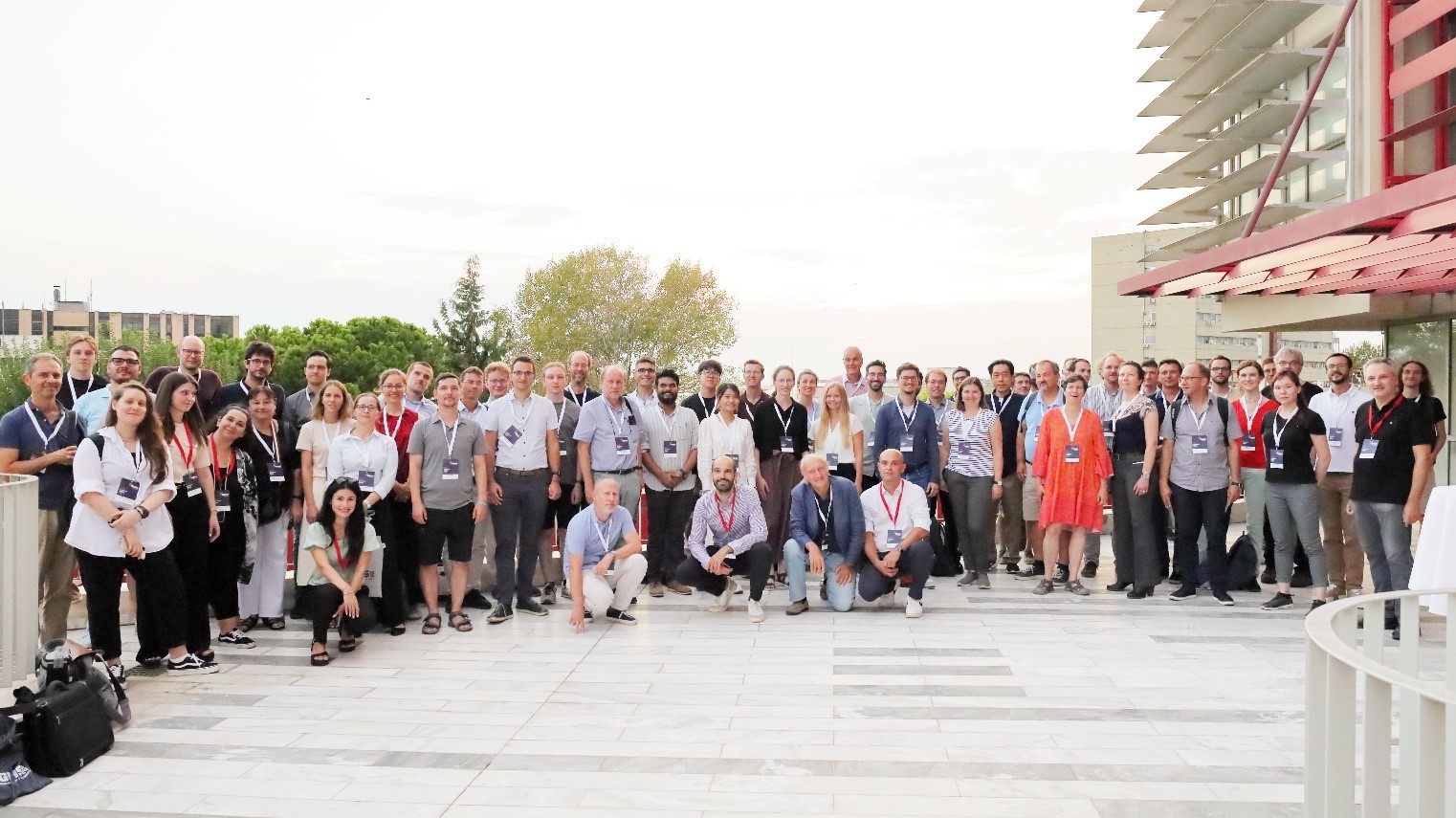
Photo of the GGHS2024 participants in the Aristotle University of Thessaloniki Research Dissemination Center
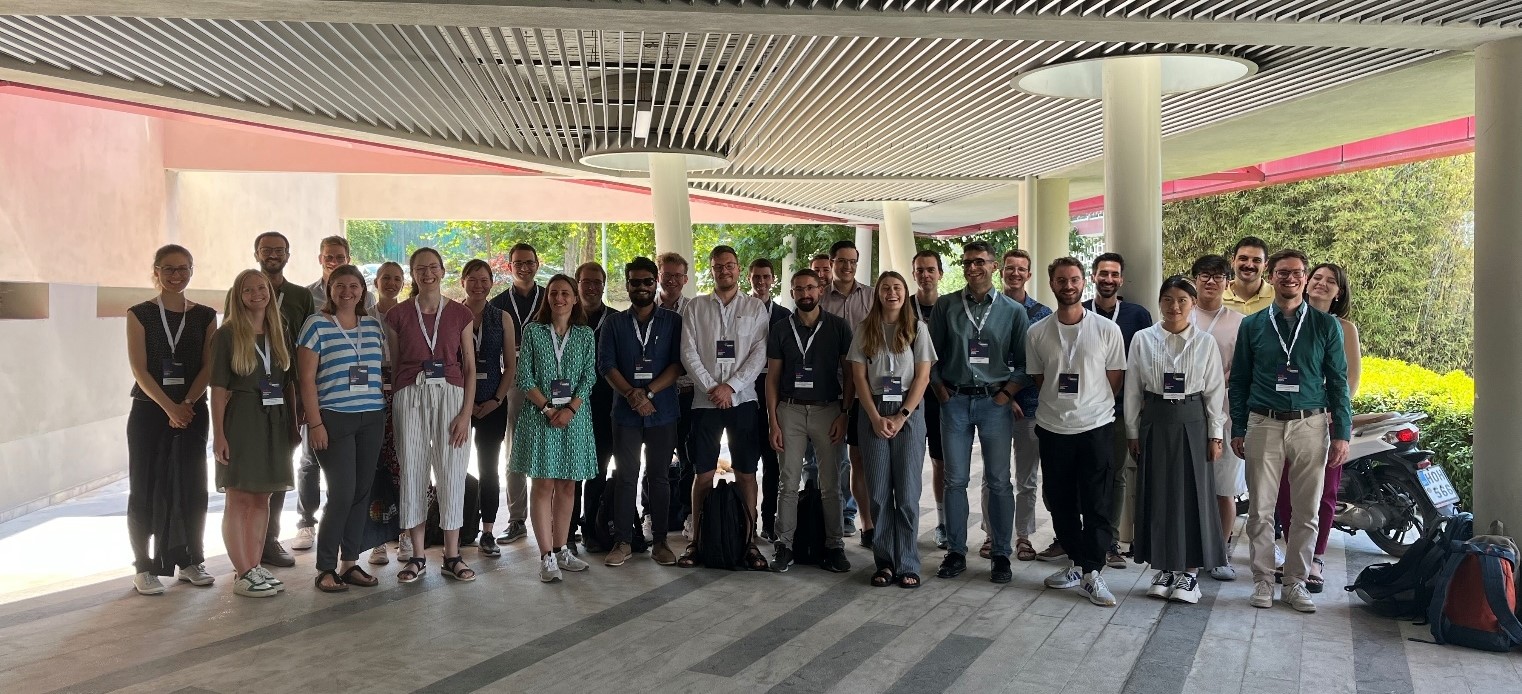
Photo of the GGHS2024 ECS participants during the conference
Georgios S. Vergos
(on behalf of the LOC)
Srinivas Bettadpur
IAG Commission2 President
Riccardo Barzaghi
IGFS President
Laura Sanchez
GGOS President
The IAG Newsletter is under the editorial responsibility of the Communication and Outreach Branch (COB) of the IAG. It is an open forum and contributors are welcome to send material (preferably in electronic form) to the IAG COB (newsletter@iag-aig.org). These contributions should complement information sent by IAG officials or by IAG symposia organizers (reports and announcements). The IAG Newsletter is published monthly. It is available in different formats from the IAG new internet site: http://www.iag-aig.org.
Each IAG Newsletter includes several of the following topics:
- news from the Bureau Members
- general information
- reports of IAG symposia
- reports by commissions, special commissions or study groups
- symposia announcements
- book reviews
- fast bibliography
| DOCUMENTS |
| IAG_Newsletter_January_2025.pdf |
